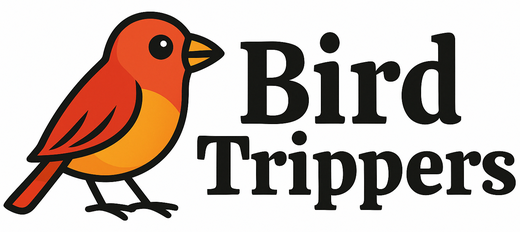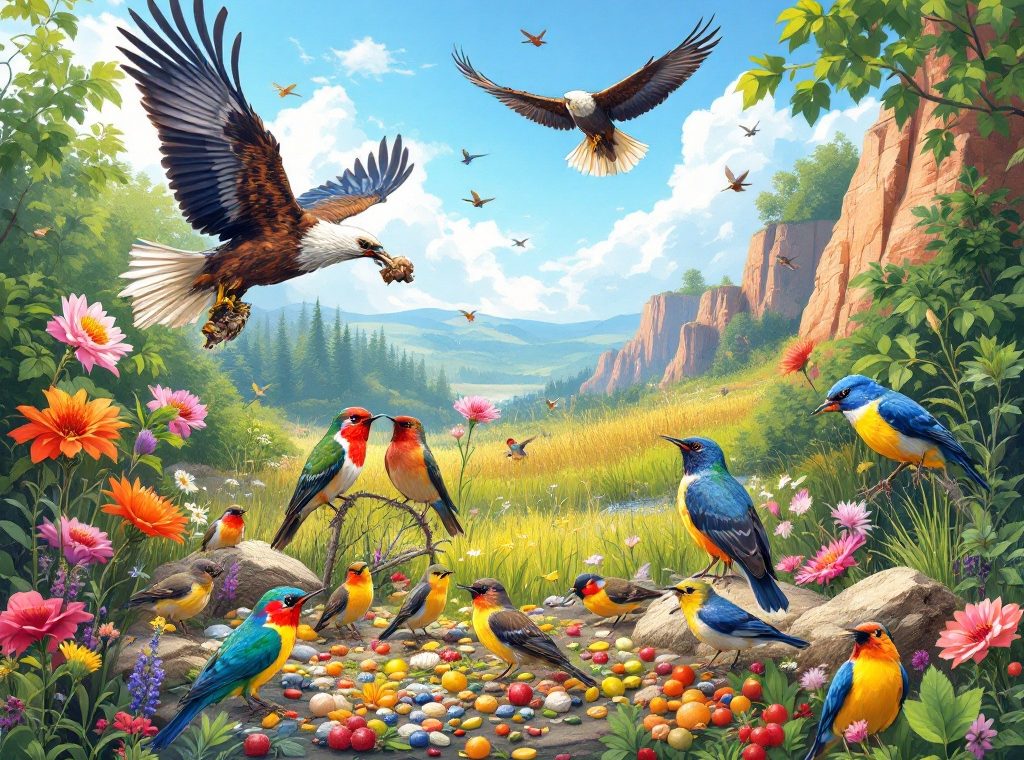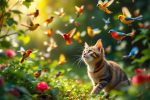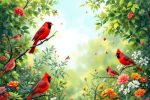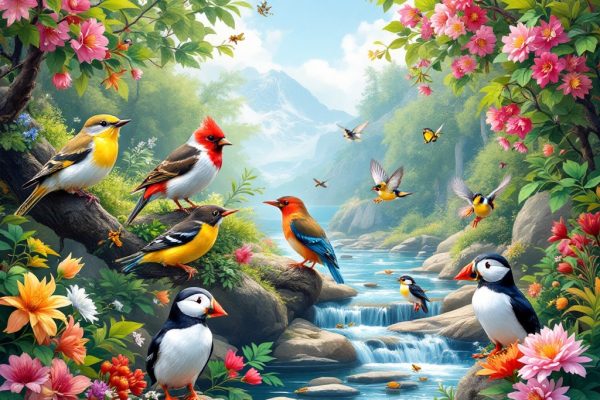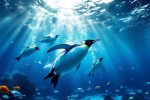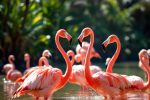Are Birds Omnivores: Diet of Different Flying Animals
Ever wondered what birds eat? Many birds are surprisingly flexible eaters, enjoying a diverse omnivorous diet of fruits, seeds, insects, and even small animals. This adaptability helps them thrive in various habitats. Discover the fascinating world of bird diets, from specialized carnivores like eagles to nectar-loving hummingbirds, and explore how their feeding habits impact their survival. Learn how seasonal changes and the demands of raising young affect their food choices. Delve into the prehistoric past and uncover the dietary secrets of ancient flying reptiles like pterosaurs. Fly into the article and uncover the secrets of bird diets!
Important information
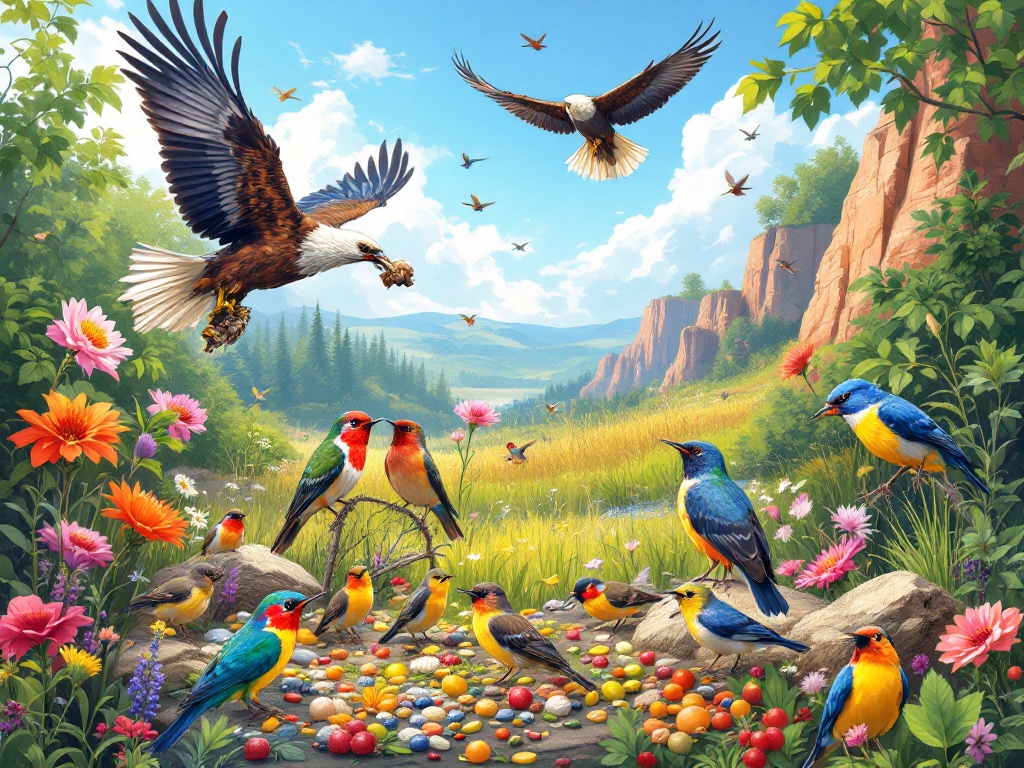
- Many birds are omnivores, meaning they eat both plants and animals. This gives them flexibility to survive in changing environments.
- Birds’ diets often change with the seasons. They may eat insects in the summer and berries in the winter.
- Carnivorous birds like eagles and hawks primarily eat other animals, while herbivores like finches mainly consume plants.
- Young birds need lots of protein from insects for proper growth.
- Prehistoric flying animals, like pterosaurs, had varied diets, including fish, fruit, and hard-shelled creatures.
Understanding Bird Diets: Are Birds Omnivores?
Many birds are omnivores, enjoying a diverse menu of plants and animals. Their diet includes fruits, seeds, nectar, insects, worms, and even small mammals. Some also consume fish or carrion. This dietary flexibility allows them to adapt to environmental changes, such as seasonal food fluctuations.
- fruits,
- seeds,
- nectar,
- insects,
- worms,
- small mammals,
- fish,
- carrion.
However, not all birds are so adaptable in their eating habits. Carnivores like eagles and hawks, skilled hunters known as raptors, primarily prey on other animals. Conversely, herbivorous birds, such as finches and hummingbirds, focus on plant-based foods like seeds, fruits, and nectar. The omnivorous diet offers a significant advantage, providing a wide range of nutrients that enhances survival across various habitats.
- Carnivores: eagles and hawks (raptors),
- Herbivorous birds: finches and hummingbirds.
What Defines an Omnivorous Bird?
Omnivorous birds thrive on a diverse diet, consuming both plants and animals. Their meals range from seeds and fruits to insects and small creatures, giving them dietary flexibility. This adaptability allows them to adjust to changing food availability, increasing their survival chances. Many omnivorous birds change their dietary habits as they mature. Younger birds often focus on insects, while adults incorporate more plants, such as berries and seeds, into their diet.
Plant-Based Foods in Bird Diets
Omnivorous birds thrive on a diverse diet of plant-based foods, including seeds, fruits, nuts, grains, and nectar. A bird’s specific plant preferences vary depending on its species and habitat. For example, finches have a preference for seeds, while hummingbirds primarily consume nectar. Orioles and tanagers favor fruit, and many bird species also incorporate grains into their diet.
Animal-Based Foods Consumed by Birds
Omnivorous birds thrive on a diverse diet consisting of both plants and animals. Common insects in their diet include beetles, grasshoppers, and ants. They also consume small fish, such as minnows and fry, and occasionally eat eggs from other birds or reptiles. Growing chicks and juveniles, especially, need a protein-rich diet primarily composed of animal-based foods for proper development and healthy growth.
Classification of Birds Based on Dietary Habits
Birds display a fascinating variety of dietary preferences. Some are carnivores, preying on other animals. Their diets might include insects, fish, or even small mammals. Herbivorous birds, on the other hand, mainly eat plants. Seeds, fruits, and nectar are their primary food sources. Omnivorous birds consume both plants and animals, showcasing adaptability in their food choices. This dietary diversity is reflected in the specialized adaptations seen in some species. Certain birds have beaks perfectly designed for specific food types, like the long, thin beaks of hummingbirds ideal for sipping nectar, or the strong, hooked beaks of raptors made for tearing flesh. Others are opportunistic feeders, consuming whatever is available, a strategy that allows them to thrive in changing environments.
Omnivores, Carnivores, and Herbivores: What’s the Difference?
Animals have diverse dietary preferences. For example, bears are omnivores, eating both berries and fish. Lions, as carnivores, mainly hunt zebras. Herbivores like cows graze peacefully in fields, demonstrating their plant-based diets. These varied eating habits are crucial in defining each animal’s role in the ecosystem.
Specialized vs. Opportunistic Feeders
Some animals are picky eaters. For example, hummingbirds prefer nectar, and snail kites mainly eat apple snails. This narrow diet makes them dependent on these specific food sources.
Other animals, like crows and gulls, are much more adaptable. They are opportunistic feeders, eating a wide variety of foods depending on what’s available. This flexibility helps them survive, even when food is scarce or their environment changes.
Dietary Adaptations and Survival Strategies
A bird’s diet adapts to the seasons based on food availability. During breeding season, many birds rely on protein-rich insects to fuel reproduction. In autumn and winter, these same birds switch to berries and seeds due to insect scarcity. This dietary flexibility is essential for survival, especially for migratory birds encountering diverse food sources. Chicks and fledglings require a different, protein-rich insect diet for rapid growth, even if their parents primarily consume plants at other times.
Seasonal Diet Changes in Birds
A bird’s diet changes dramatically with the seasons. During migration, birds like warblers and thrushes need lots of energy. They eat high-calorie foods like berries, fruits, and insects, which are full of fats and lipids to fuel their long flights.
When it’s breeding season, birds need more protein. Warblers and thrushes switch to a diet of insects and invertebrates like caterpillars, spiders, and earthworms. This helps them produce eggs and raise their chicks.
In winter, insects are scarce. Birds like finches and sparrows eat seeds, nuts, and berries to survive. Some birds, such as jays and nutcrackers, store food like nuts and seeds during other seasons and rely on these hidden caches to get through the cold months.
Dietary Needs of Chicks and Juvenile Birds
Young birds need a diet rich in protein for their rapid growth. This high-protein intake, often comprised of more insects and animal matter than an adult bird’s diet, is essential for healthy skeletal growth and feather development. This specialized diet is crucial for their survival.
Comparative Diets of Prehistoric Flying Animals
Prehistoric flying animals navigated a unique world, with ancient ecosystems presenting both obstacles and opportunities. Pterosaurs, in particular, displayed remarkable adaptations, as evidenced by the diverse feeding strategies revealed in fossil records. These adaptations were crucial for their survival and diversification, allowing each species to carve its own niche within the ancient ecosystem.
Piscivores
some pterosaurs were piscivores, consuming fish.
Frugivores
Others, like the tapejarids, may have been frugivores, feasting on fruit.
Durophages
Still others, the durophages, likely ate hard-shelled invertebrates.
Ancient Ecosystems and Dietary Strategies
Ancient ecosystems were full of life, including various prehistoric flying animals. Early birds and pterosaurs occupied diverse niches in the food web, their diets defining their roles as predators, prey, or scavengers. Some pterosaurs were fish-eaters, while others hunted insects or small terrestrial creatures. Fossil evidence, like stomach contents and coprolites (fossilized droppings), offers insights into these ancient feeding habits. These clues help us understand the complex relationships between these airborne animals and their environments, improving our knowledge of prehistoric ecosystems and the dynamics of past food webs.
Pterosaurs and Tapejarids: Insights from Fossil Findings
Scientists suspect tapejarids were omnivores, possibly leaning more towards a plant-based diet. Fossil evidence illuminates their eating habits, revealing their role within the ancient ecosystem. This helps us understand their place in the prehistoric world.
